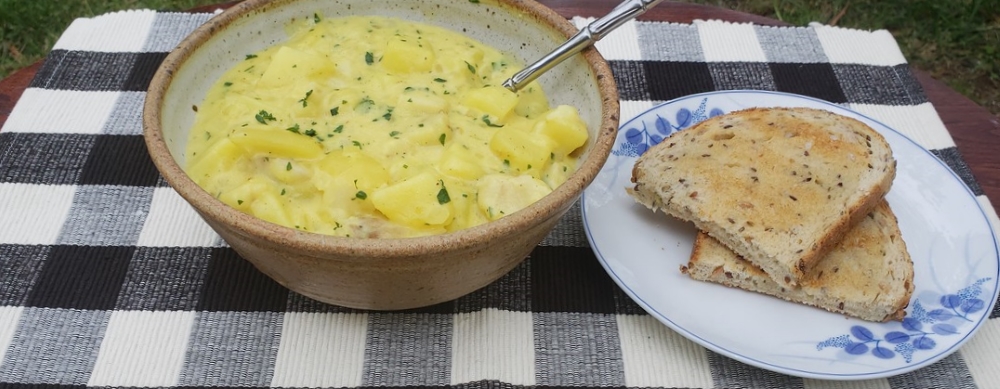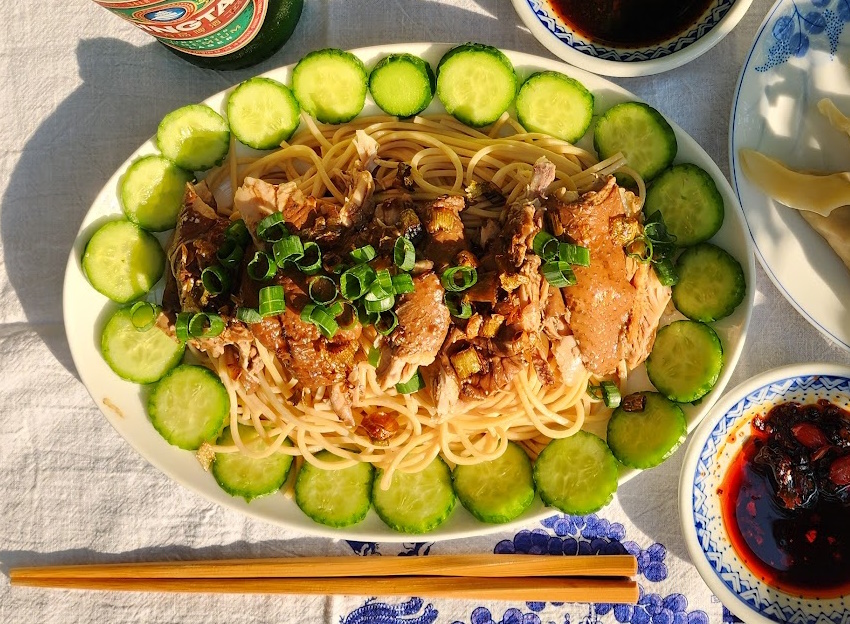Our recipe of the month, Icelandic Plokkfiskur, is a hearty simple-to-prepare dish with only a few easy-to-find ingredients. It's an archetypal comfort food enjoyed by Icelanders of all ages.

With a population of only 371,000 and a land area of 40,000 square miles, Iceland is the most sparsely populated country in Europe. Iceland is called the land of "Fire and Ice" because of all the glaciers and active volcanoes there. Although some of the first inhabitants may have been Gaelic Celts from Ireland, the island was taken over by Norwegian Vikings in 874 CE. Its capital is Reykjavík, where 60% of the nation's population resides. Most of what is known about early Icelandic history is from a poetry anthology, The Prose Edda, compiled by Snorri Sturlusson in the early 13th century. Instead of a generous and benevolent Santa Claus, Icelanders have the 13 “jólasveinar” or “Christmas lads”, ugly little mischievous men with names such as Doorway-Sniffer, Bowl-Licker, Candle-Stealer and Sausage-Swiper. Children put a shoe on the sill of their bedroom window and if they have misbehaved they might just find a rotten potato or some other awful gift in their shoe! Iceland can lay claim to be the country safest for women, and they had the 1st female prime minister in Europe. This year (2021) they were two seats short of having a majority in Parliament even though, unlike some other European countries, there are no quotas for parliament seats. And most Icelanders don't have family names—their surnames are either patronymic or matronymic, with a suffix of either "son" or "dottir" added to either one's father or mother's given name. And any new first names have to be approved by the Icelandic Naming Committee!
Being an island ill-suited to agriculture (except root crops and rather surprisingly, they once had the largest banana plantation in Europe), fish and meat (particularly lamb) are prominent in Icelandic diets. Iceland is also known for some foods that outsiders (and nowadays, perhaps many Icelanders themselves) view as being rather odd, like fermented shark fins, sour lamb's testicles, whale meat, blood pudding, puffin hearts and lamb's head. But that is simply a reflection of the survival challenges of days gone by when every part of an animal was used or consumed. It's been said that many of those specialties are mostly eaten by tourists looking for an authentic Icelandic experience. Vegetables are common today, but not so in the past.
In days-gone-by Icelanders would buy whole sides of fish, and Plokkfiskur was a way to prepare left-over fish. The potatoes make the dish even more hearty. As with many national foods, individual cooks often embellish the basic recipe of fish and potatoes with additional ingredients. Popular additions are yellow curry powder, mustard or grated cheese. The dish is enjoyed by people of all ages, but apparently it is a particular favorite with children. It is probably fair to say that Plokkfiskur is the macaroni and cheese of Iceland. The fish used is usually either cod or haddock. One source says that in the past haddock was more commonly used because the Icelandic fishing operations would salt the cod they caught and ship it to Europe mirroring the pattern seen in many other countries where premium products are often unavailable to locals as they are destined for export. Today eating cod is ubiquitous in the island nation.
Cook's note: In Iceland it is typical to boil potatoes in their skins, cool them in cold water and then peel them. I'm not sure what the benefits are of doing this; it's up to you to decide which you prefer, peeled and then boiled or boiled and then peel. Also, I usually cube potatoes before I boil them. Perhaps potatoes, like shrimp, are more flavorful if cooked before being peeled. Potatoes are an Icelandic staple and are eaten boiled, french-fried, mashed and even caramelized (Brúnaðar Kartöflur). It appears that white and red potatoes are the most common.
Plokkfiskur is basically a fish, potatoes and onion in béchamel sauce dish. Note that the recipe calls for mixing the hot milk into the butter/flour/onion roux. A bit more difficult (but still possible) method is to mix the roux into the warm milk. The flour is "cooked" in the butter until it loses its raw flour taste, but it should not be cooked too long, or it will brown
One way of serving Plokkfiskur is to layer grated cheese on top and bake the previously cooked Plokkfiskur until the cheese is golden brown.
Ingredients:
- 1 pound of either cod or haddock, cut into large cubes
- 1 pound of new or white potatoes
- 1 large yellow onion, finely chopped
- 2 tablespoons general purpose flour
- 4 ounces of butter
- 2 1/2 cups of milk
- 1 cup white cheddar, grated
- 1 teaspoon yellow curry powder (optional)
- Salt and pepper to taste
Preparation:
- Wash and peel the potatoes (see note above)
- Boil the potatoes until fully cooked.
- In a medium sized pot bring the milk to a simmer and poach/boil the fish until done.</>
- When done, remove the fish and set aside.
- In a different medium pot, lightly sauté the onions in the butter until the onions are soft.
- Mix the flour into the pot with the butter and onions and continue heating for one additional minute; do not let it brown.
- Whisk the warm milk into the pot with the butter and onions.
- Mix in the cheddar and curry powder (both optional).
- Continue heating until the sauce has thickened.
- Cut the boiled potatoes into large chunks.
- Mix the potatoes and cooked fish into the pot and continue heating for 2 minutes.
- Serve with a hearty bread.
Njóttu máltíðarinnar! (bon appetit)
Recipe by T. Johnston-O'Neill
Photos by Shari Johnston-O'Neill









